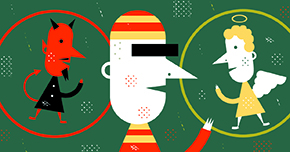 Daniel BuenoJuvenile offenders housed at “social-educative” centers sometimes display indifference to the suffering of others and also ignore social rules, but they do know – or seem to know – how to tell the difference between right and wrong. A group of psychiatrists and psychologists in São Paulo reached this conclusion after 30 residents from the ages of 18 to 21 who lived at the Fundação Casa – a correctional facility for minors convicted of serious crimes – underwent psychological testing over the course of nearly one year to evaluate their degree of psychopathy and their ability to make moral judgments (Frontiers in Psychiatry, Nov. 2013). “These youngsters showed moral maturity and knew how to tell right from wrong,” says Daniel Martins de Barros, a psychiatrist at the University of São Paulo (USP). “But we cannot say whether this knowledge was theirs to start with, or if they were merely repeating what they had heard someone else say.” These young people also took a test that measured the electrical activity of their skin and assessed their emotional response when exposed to pleasant images (like a father holding a baby in his lap), neutral images (a book on a table), or unpleasant images (mutilated people). A correlation was found between the degree of callousness detected in the psychological test and the emotional reaction assessed through the physiological test. The more that a participant’s callousness and indifference resembled that of someone with a classic psychopathy profile, the less he or she felt the impact of disturbing images that had a negatively emotional content.
Daniel BuenoJuvenile offenders housed at “social-educative” centers sometimes display indifference to the suffering of others and also ignore social rules, but they do know – or seem to know – how to tell the difference between right and wrong. A group of psychiatrists and psychologists in São Paulo reached this conclusion after 30 residents from the ages of 18 to 21 who lived at the Fundação Casa – a correctional facility for minors convicted of serious crimes – underwent psychological testing over the course of nearly one year to evaluate their degree of psychopathy and their ability to make moral judgments (Frontiers in Psychiatry, Nov. 2013). “These youngsters showed moral maturity and knew how to tell right from wrong,” says Daniel Martins de Barros, a psychiatrist at the University of São Paulo (USP). “But we cannot say whether this knowledge was theirs to start with, or if they were merely repeating what they had heard someone else say.” These young people also took a test that measured the electrical activity of their skin and assessed their emotional response when exposed to pleasant images (like a father holding a baby in his lap), neutral images (a book on a table), or unpleasant images (mutilated people). A correlation was found between the degree of callousness detected in the psychological test and the emotional reaction assessed through the physiological test. The more that a participant’s callousness and indifference resembled that of someone with a classic psychopathy profile, the less he or she felt the impact of disturbing images that had a negatively emotional content.